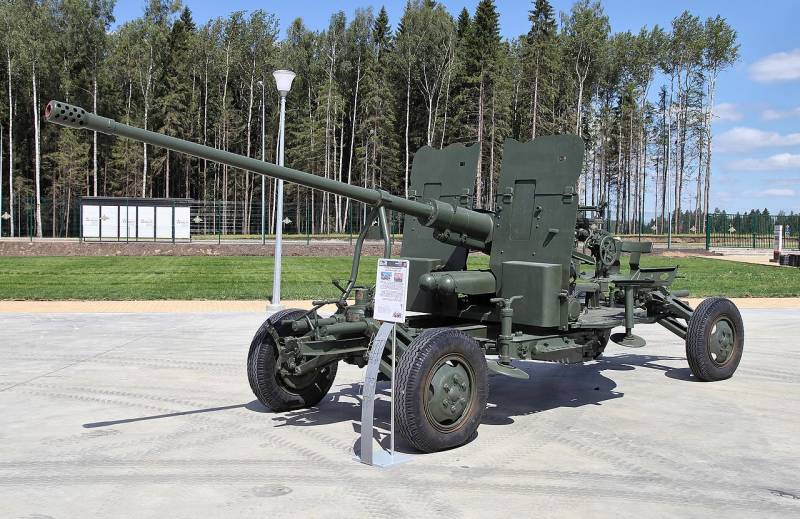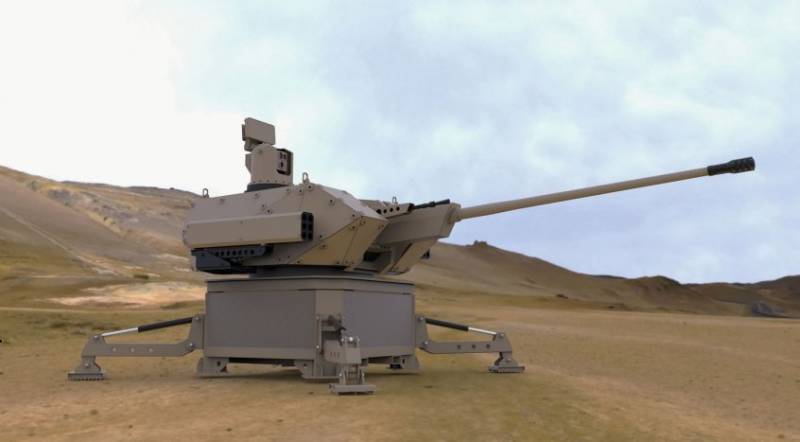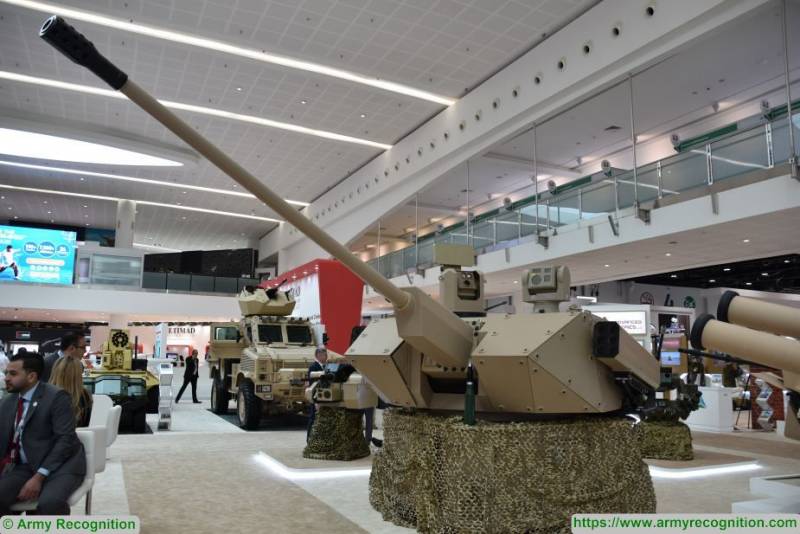Battle module Valhalla / IGG Desert Spider (Slovenia / UAE)
The existence of a new project was officially announced in February of this year during the IDEX-2019 exhibition in the UAE. In one of the pavilions of the event a full-size sample of the Desert Spider system was presented. Developing organizations have also published promotional materials. The project authors expect to receive orders, and therefore reveal all its main features and benefits.
A promising combat module Desert Spider ("Desert Spider"; perhaps it meant a specific arachnid - solpuga) was developed in the framework of cooperation between the Slovenian company Valhalla Turrets and the UAE International Golden Group. The company from Slovenia is widely known for its developments in the field of remotely controlled weapons systems, and has already managed to offer the option of a module with an 57-mm gun. Now these ideas have been implemented in the new project.
Desert Spider product is a rocket-cannon-machine-gun combat module with the possibility of transportation or placement in a stationary position. It is proposed to enhance air defense, but it can also work on ground targets. The project uses ready-made components and assemblies, which should reduce the cost of the module, as well as simplify its operation.
The module of the new type is an armored tower with a small tower for the tower, suitable for installation on different platforms. At the IDEX-2019 exhibition, the product was demonstrated on a simple stand covered with a camouflage net. In the promotional materials and statements appear other means.
So, on promotional images, the combat module is placed on a special stationary basis. It is an armored box with a set of rigidly fixed supports and folding hydraulic outriggers. In the near future, the company Valhalla Turrets promises to present a modified version of the "Spider", designed for installation on armored vehicles. This version of the module has already received the name RCWS Viper, it will be presented no later than next spring.
***
The combat module Desert Spider is made on the basis of an armored dome; spaced booking from steel panels is used. Applied wedge-shaped frontal units and inclined sides, which should enhance protection. 3 declared level of protection for STANAG 4569 - armor must withstand 7,62-mm rifle armor-piercing bullets or fragments of 155-mm projectile at a distance of 60 m. Part of the external equipment, apparently, does not have equivalent protection. The proposed stationary base for its protection should correspond to the module itself.
In the center of the tower is placed swinging part with barrel armament. The design of the tower provides circular horizontal guidance. The swinging part moves in the vertical sector from -20 ° to + 70 °, which corresponds to the tasks. With such angles, the combat module can fight both air and ground targets.
The 57-mm automatic gun AZP-57 from the Soviet-designed C-60 anti-aircraft gun was chosen as the “main caliber” of the module. This gun retains all the main units, uses standard ammunition and shows the old characteristics. At the same time, the ammunition system was changed. Instead of a clip system, continuous chain feed is used.
Inside the combat module was able to place the boxes for 92 shells. The gun can use two types of 57x348 mm R unit shots: the OP-281 fragmentation tracer and the BR-281 armor-piercing tracer. Due to the new ammunition system, the combat rate of fire has been increased to 120 rounds per minute. The firing characteristics remain the same: the effective firing range - 6 km, reach height - 5 km.
Together with the cannon, the KPVT heavy machine gun is placed on the swinging part. Its ammunition includes 300 xNNXX mm 14,5 cartridges in one tape. Depending on the type of target and other conditions, the machine gun is able to conduct effective fire at distances up to 114-1500 m.
On the sides of the combat module there are two packages of guides for rocket armament. The package is an armored box with six longitudinal tubular guides caliber 70 mm. Packages have vertical-guidance drives. Two such launchers can be used with 70-mm unguided or guided missiles of existing and prospective types. It is assumed that missile weapons can be used against various targets in the air and on the ground.
On the roof of the tower are placed two sights for the commander and gunner. For the commander is a panoramic combined sight with a range finder. On the casing of this sight is installed a compact radar antenna. The gunner has only optical devices. Available tools allow you to find different targets at ranges up to 15-20 km - depending on the conditions and type of objects. By cable or radio channel, data from the sighting devices should be transmitted to the calculation panels. Back come commands for mechanisms and weapons. The consoles themselves can be located at a distance from the combat module - on different machines or in protected structures.
The mechanisms of the combat module Valhalla / IGG Desert Spider are built using electric drives. Their work is provided by the built-in rechargeable battery. Its capacity allows the module to work for 14 days. Also, the product can be connected to an external energy source, which expands the possibilities for long-term duty.
The combat module in a stationary configuration has a total length of the order of 7 m and a height of more than 2-2,5 m. The mass in this form is about 5 t. When developing a new modification of the Desert Spider for mounting on armored vehicles, it is planned to reduce the system weight to 3850 kg. To this end, the designers donate an 14,5-mm machine gun, instead of which they use weapons of the caliber 12,7 mm. Launchers for 70-mm missiles will be replaced with other products, and the radar will be removed.
***
The first official demonstration of the combat module Desert Spider took place just a few weeks ago, and it is too early to talk about signing contracts for the supply of such products. However, it is already possible to evaluate the joint project of Slovenia and the United Arab Emirates, as well as try to predict its real prospects.
The "Desert Spider" product is offered primarily for use in air defense, although its use against ground targets is not excluded. In the context of air defense, the module can play the role of a short-range defense system that complements other anti-aircraft systems. Independent use of Desert Spider leads to known risks: the firing range of its main weapon is noticeably inferior to the drop range of modern aviation means of destruction. Thus, the new combat module should be considered only as a means to "finish off" targets that have broken through other echelons of defense.
Of particular interest is the Desert Spider in the context of the fight against ground equipment. In recent decades there has been a tendency to increase the protection of military vehicles; modern samples can withstand the hit of 30-mm projectiles. Thus, for their defeat, artillery of increased caliber is required - such as the C-60 / АЗП-57 cannon. Its presence not only guarantees the defeat of cars with light and medium armor, but also increases the effective range.
Additional armament in the form of a KPV machine gun and 70 mm missiles significantly expands the range of tasks to be solved. Thanks to them, the combat module gets the opportunity to attack a specific target using the most effective ammunition in this case. This eliminates excess exposure and saves money.
The old 57-mm gun has obvious advantages, but it is not without flaws and may not fully meet modern requirements. The Desert Spider module should use fragmentation and armor-piercing projectiles of the old types, which can hit the target only with a direct hit. The probability of hitting the target could be increased with the help of an 57-mm projectile with a programmable fuse, but such products are currently being developed only in Russia. Whether Slovenian and Emirates enterprises will be able to develop such ammunition or obtain foreign products is a big question.
Stationary placement of the module may lead to unnecessary risks. Like any other means of air defense, it is a priority goal for the enemy. As a result, the inability to quickly leave the position and go to a safe place is a serious drawback. However, in this case, taken some measures. The module has a bulletproof reservation and is partially protected from artillery. Control panels are located at a distance from the module itself, which reduces the risks for operators.
It must be admitted that the combat module Valhalla / IGG Desert Spider has a number of positive features due to which it can have certain commercial prospects. A stationary or transportable air defense system with an increased power tool may be of interest to some customers. In addition, the subject of contracts in the future may be its modification, designed for installation on armored vehicles.

The C-60 anti-aircraft gun is precisely her cannon used on the Desert Spider. Photo by Vitalykuzmin.net
However, with all its advantages, the Desert Spider project has significant drawbacks that could disappoint a potential customer. In addition, despite the presence of a certain interest on the part of the armies, modern artillery systems like the one proposed so far have not received noticeable distribution.
You can also remember history Valhalla Turrets, which does not allow to look to the future with optimism. Over the past few years, Slovenian engineers, independently and in cooperation with their foreign colleagues, have developed a number of combat modules with different capabilities. In particular, in 2017, such a product was already offered with an 57-mm gun. However, none of these developments has yet gone beyond the exhibition pavilion. Slovenian combat modules attract attention, but nobody orders them.
It is possible that cooperation with a company from the UAE will not lead to a change in the situation, and Desert Spider will replenish the list of projects without real prospects. In the future, this may even lead to the closure of the development company. However, a positive outcome is possible, in which the joint Slovenian-Emirate development will still reach the series. It remains only to wait News.
***
It should be noted that the Valhalla / IGG Desert Spider project should be of particular interest to Russian specialists and lovers of military equipment. The fact is that it to a certain extent repeats the concept implemented in the domestic project of the AU-220М “Baikal” module. The creation of a remote-controlled system with an 57-mm automatic cannon as the main weapon is again proposed. In certain circumstances, the Desert Spider may even become a competitor of Baikal in the international market. However, such a competitor should not be overestimated.
The emergence of new projects from Valhalla Turret and related organizations leads to an important conclusion. It seems that foreign designers have studied Russian ideas about the return of 57-mm artillery to the system and began to work out their projects of this kind. Until now, these developments have not received any distribution, but in the future the situation may change. In the meantime, defense enterprises should develop their projects, study other people's developments and prepare for the possible beginning of fierce competition. Demand for combat modules with 57-mm guns may appear at any time.
On the materials of the sites:
http://valhalla-turrets.com/
http://iggroup.ae/
https://janes.com/
https://armyrecognition.com/
https://defence.pk/
https://bmpd.livejournal.com/


Information